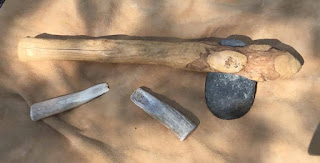Friday, February 26, 2021
Tuesday, December 8, 2020
Making a bone fishhook from the phalanx bone of a deer leg is tedious work requiring scoring, drilling, and scraping. “Actually, fishhooks were used more sparingly than might be expected. Hooks aren't always as efficient as other techniques of catching fish. This is true today just as it was thousands of years ago. For instance, special events in weather such as receding flood water might supply a community with an easy catch of fish if they are concentrated in small pools. The fact that fishhooks weren't the main choice of ancient cultures for catching fish has been proven from the excavations of archaeological sites around the world. Many of these sites may produce large amounts of fish bones but few or no examples of fishhooks.” -Peter Bostrom
Monday, December 7, 2020
I acquired several white tail deer leg rawhide skins. Basically these were skinned, scraped, and dried. A neck knife sheath was made simply by cutting to size, punching holes with an awl, and lacing with buckskin thongs. The knife is Missouri chert hafted into a Buffalo rib handle secured with sinew.
Pottery
I was firing some pottery this summer and apparently did not dry and pre-heat sufficiently. There must have still been moisture in the clay, and it blew off a spall. Grinding the spall to shape, and drilling a hole, with stone tools, I made a pendant. The pot was imprinted by rolling a corn cob over the surface before drying. Pots were often imprinted to make it easier to grip a slippery pot. Also, the texturing gave the pot more surface area which made heat transfer more efficient during cooking. This texturing helped to protect the pot from thermal shock.
Monday, January 20, 2020
Antler Wedges
Wanted to do an impromptu experiment. First, I picked the warmest, humid morning I could find while visiting family in Missouri. I had read a paper on the use of antler wedges to fell trees, in the Yukon, by indigenous peoples 3000 years ago. I was curious how well antler wedges would do downing 2-inch diameter shelter poles. To compare, I cut one tree using a Virginia greenstone celt axe I had pecked. I had a couple of medium sized white tail deer antler wedges, and for the mallet I used the axe handle with the celt removed. What did I learn? Energy-wise, the axe was harder effort to use & control, shredded the sapling more in the process. The antler wedge and mallet were easier, and cleaner, incising around the pole with more precision. The sapling was bent and the wedge used to cut thru the stressed fibers. The first wedge I used, I saw my mistake I made, when I ground it down. I ground from two sides putting some of the pithy area of the antler on the working edge. This started flaking away after a few strikes. So, I switched to the wedge I had only ground from one side, leaving the strong dense outer layer as the edge. This worked fine. I did notice a small area peeled back which could easily be ground again. Both methods took about the same amount of time on green wood. My opinion...I like the antler wedge. It’s a cleaner cut, easier to use, lighter to carry, faster to re-grind...something I need to play around with more. I reviewed a number of archaeological site inventories and noticed awls and wedges were the most numerous bone/antler items recovered. As an over sight, I simply had not really considered the value of wedges in the primitive tool kit. But, you need a wedge to split the wood to make a bow, thin a fireboard, create an atlatl blank, and more.
Thursday, May 2, 2019
Subscribe to:
Comments (Atom)


















